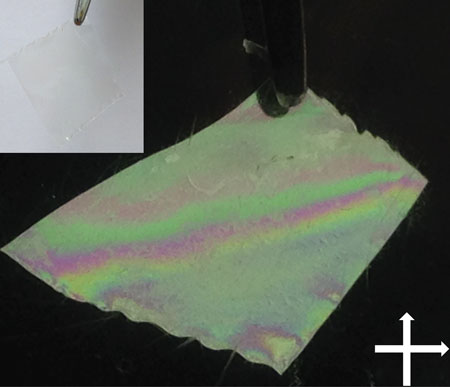| Posted: Jan 13, 2015 | |
Liquid crystalline polymer dispersed liquid crystals |
|
| (Nanowerk Spotlight) Polymer Dispersed Liquid Crystals (PDLCs)1 are micrometer-sized birefringent Liquid Crystal (LC)2 domains dispersed in an optically transparent continuous polymer matrix. | |
| The peculiarity of a PDLC system is that of scattering different amounts of an impinging light beam intensity, depending on the strength of an external electric field that is, eventually, applied to the system. In fact, by simply adjusting this value, a PDLC film (tens of µm thick) can continuously pass from a highly scattering, opaque, state to a transparent one. | |
| The modulation from this scattering to transparent state has been the basis for a huge variety of PDLC-based LCD-devices3, 4. | |
| A variety of methods5 have been employed to prepare PDLC materials in which the size-scale of the phase separated LC domains is smaller than the wavelength of visible light, yielding initially optically clear materials. In these so-called 'nano-PDLCs', the dynamic electric-field re-orientation of the LC domains can be utilized for phase modulation applications. | |
| However, the small domain size and extensive surface interaction of the LC and the polymer increases switching voltages which ultimately has limited the utility of nano-PDLCs as phase modulators. | |
| Researchers from BEAM Co. and the Air Force Research Laboratory have realized new generation of polymer-dispersed liquid crystals based on a room temperature, polymerizable, nematic LC host (PLC-2014C, synthetized by BEAM Co.). | |
 |
|
| Figure 1: Free-standing LCPDLC film between crossed polarizers and in standard ambient light (top left) (© AIP Publishing) | |
| These liquid crystal polymer/liquid crystal composites, LCPDLCs, exhibit excellent optical and electro-optical properties with negligible scattering losses in both ON and OFF states (see paper in Applied Physics Letters: "Ultra-fast solid state electro-optical modulator based on liquid crystal polymer and liquid crystal composites"). | |
| LCPDLCs can act as solid-state electro-optical modulators that possesses low-voltage drive (4-5V/µm), ultra-fast and symmetric response times (∼200µs) and large phase modulation capability of LCs. | |
| The LCPDLC film can be delaminated from the cell substrates without losing its macroscopic alignment and optical transparency and can be handled as a free standing film (Figure 1). The ultra-fast and wide range control of the phase modulation is obtained through an easy manufacturing process. This effort represents an important step-forward which can foster future advanced applications such as ultra-fast phase modulators, electronic shutters and displays. | |
| References | |
| 1) Introduction to Polymer-Dispersed Liquid Crystals | |
| 2) Introduction to Liquid Crystals | |
| 3) "Electro-optic response of polymer dispersed liquid-crystal films" | |
| 4) "Phase modulation with polymer-dispersed liquid crystals" | |
| 5) "Liquid Crystal Dispersions" | |
|
By Luciano De Sio, BEAM Co.
|
|
|
Become a Spotlight guest author! Join our large and growing group of guest contributors. Have you just published a scientific paper or have other exciting developments to share with the nanotechnology community? Here is how to publish on nanowerk.com. |
|
